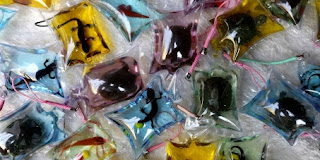The Silent Harvesting of Kangaroos
THE SILENT HARVESTING OF KANGAROOS
Not many people outside of Australia eat kangaroo meat and the people
who do think that it’s a more ethical and sustainable alternative to other
animal products. However, in reality, the kangaroo industry is just as cruel
and untenable.
Approximately 3 million of these highly social and intelligent kangaroos
are killed commercially in Australia each year. Kangaroos are known to be
fragile animals that live in an emotionally and socially rich mob structure.
There is strong evidence to show that kangaroos form strong bonds amongst one
another and grieve when one of the mob is lost.
Unlike other animals raised for food such as cows and pigs, kangaroos
are shot in their remote, natural habitat by people ranging from recreational
to professional hunters. This allows for no effective monitoring of animal
welfare.
While the relevant Commonwealth Codes of Practice for “humane”
commercial kangaroo shooting requires kangaroos to be slaughtered via a single
shot to the head, the capacity of a clean kill can be impaired by many factors.
Such factors include poor visibility as kangaroo hunting usually takes
place at night, the size of the kangaroo’s head presenting a small target, and
some shooters’ limited skills and inexperience.
Even conservative estimates suggest that more than tens of thousands of
adult kangaroos commercially “processed” each year are not killed in a clean
manner. Instead, it is likely that many kangaroos are simply wounded and endure
a long and painful death.
Furthermore, kangaroos that are shot in the body cannot be commercially
harvested for meat. These victims are simply left in the field as they are no
longer profitable and left to suffer in agony.
Then there are the estimated 1.1 million dependent joeys at foot or in a
pouch, a year, which are considered “collateral damage” by the industry. The
young are either bashed to head on the head with a metal pipe or against the
tow bar of the hunter’s truck or decapitated. The Code refers to this as
“euthanasia”. Alternatively, once their mother is killed, the joey is abandoned
and left to starve.
Kangaroos are often butchered in the field and transported on unrefrigerated
open trucks. A two-year investigation conducted by the Wildlife Protection
Association of Australia and Animal Liberation NSW found that many of the
carcasses stored by this industry were contaminated by dangerous bacteria,
including E. coli, streptococcus, and staphylococcus.
Moreover, environmental arguments that kangaroo meat is a sustainable
alternative to cows and lamb do not withstand rigorous scientific scrutiny,
according to ecologists Dr. David Croft, Dr. Dror Ben Ami and Dr. Dan Ramp from
the 'THINKK' tank at the University of Technology (UTS) Sydney.
They found that to provide Australians with just one small portion of
kangaroo meat a week, 22 million kangaroos would have to be slaughtered every
year. The total population of kangaroos would need to be 151 million to support
this demand. This is more than five times the 30-year average population of 27
million.
Kangaroo meat may also not be as healthy as previously thought after
scientists found a component of red meat called L-carnitine, most prevalent in
the Australian animal, is associated with the buildup of plaque in arteries
which causes heart attacks, strokes, and vascular diseases.
Not only that, but fresh kangaroo meat is poisoning our animals too. A
Today Tonight investigation has revealed some pet meat made from kangaroo could
be harming and even killing our pets. Veterinarian Dr. Rita Singh found that
the kangaroo meat was loaded with dangerous preservatives, namely Sulphur
dioxide.
Sulphur dioxide is added to fresh pet meats and fish to preserve it, mask
the smell and prevent discolouration. It is not allowed in meat meant for human
consumption but it can be dangerous for pets as it destroys vitamins essential
to survive.
Kangaroos are also slaughtered for other products in the form of leather
to make sporting shoes, gloves, accessories and, souvenirs.



Thank you for sharing this article, loaded with truth and relevance about such a gentle and unique creature.
ReplyDeleteFor some reason, I have been thinking about this and curious. Now, I am mortified. I hope you continue to spread the word about this ugliness. I am so sad and mad right now. But, I appreciate your honesty about this horrific practice.
ReplyDeleteThank you for sharing and spreading the awareness.
ReplyDelete